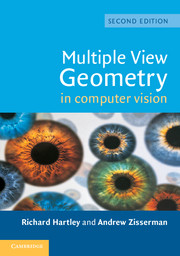Book contents
- Frontmatter
- Contents
- Foreword
- Preface
- 1 Introduction – a Tour of Multiple View Geometry
- PART 0 The Background: Projective Geometry, Transformations and Estimation
- PART I Camera Geometry and Single View Geometry
- PART II Two-View Geometry
- PART III Three-View Geometry
- PART IV N-View Geometry
- PART V Appendices
- Bibliography
- Index
PART IV - N-View Geometry
Published online by Cambridge University Press: 25 January 2011
- Frontmatter
- Contents
- Foreword
- Preface
- 1 Introduction – a Tour of Multiple View Geometry
- PART 0 The Background: Projective Geometry, Transformations and Estimation
- PART I Camera Geometry and Single View Geometry
- PART II Two-View Geometry
- PART III Three-View Geometry
- PART IV N-View Geometry
- PART V Appendices
- Bibliography
- Index
Summary
Outline
This part is partly a recapitulation and partly new material.
Chapter 17 is the recapitulation. We return to two- and three-view geometry but now within a more general framework which naturally extends to four- and n-views. The fundamental projective relations over multiple views arise from the intersection of lines (back-projected from points) and planes (back-projected from lines). These intersection properties are represented by the vanishing of determinants formed from the camera matrices of the views. The fundamental matrix, the trifocal tensor, and a new tensor for four views – the quadrifocal tensor – arise naturally from these determinants as the multiple view tensors for two, three, and four views respectively. The tensors are what remains when the 3D structure and non-essential part of the camera matrices are eliminated. The tensors stop at four views.
These tensors are unique for each set of views, and generate relationships which are multi-linear in the coordinates of the image measurements. The tensors can be computed from sets of image correspondences, and subsequently a camera matrix for each view can be computed from the tensor. Finally, the 3D structure can be computed from the retrieved cameras and image correspondences.
Chapter 18 covers the computation of a reconstruction from multiple views. In particular the important factorization algorithm is given for reconstruction from affine views. It is important because the algorithm is optimal, but is also non-iterative.
Information
- Type
- Chapter
- Information
- Multiple View Geometry in Computer Vision , pp. 409 - 410Publisher: Cambridge University PressPrint publication year: 2004
